In Part 1 of this article, I described my detailed tour of the Nolan Helmets factory in Brembate di Sopra, Italy.
I learned about the polycarbonate motorcycle helmet manufacturing process and all of the work that it takes to create a Nolan helmet.
During my tour, I also visited a separate Nolan facility used for manufacturing the composite shells of the Nolan Group X-Lite helmets.
The process is completely different, although the painting and decal work is similar.
Nolan has developed many trade secrets for manufacturing their composite helmets and I was sworn to secrecy at the front gate, so unfortunately I’m not at liberty to discuss it.
However, I also visited the helmet safety standards test labs at Nolan.
That is where both the polycarbonate and the composite X-Lite helmets are developed and tested and the designs certified to meet the various worldwide standards in the over 70 countries where Nolan helmets are sold.
I’d like to again thank the Nolan staff for providing this most excellent and enlightening tour and for allowing me such free access to the entire facility. And don’t forget lunch!
A huge amount of information — or should I say misinformation — exists regarding the differences between worldwide motorcycle helmet safety standards.
Unfortunately, even with all that information, there isn’t a consensus among motorcycle riders on which standard provides the most protective, or “safest” helmet.
Even the experts don’t agree (and apparently don’t really know) which test and what type of forces will optimize protection for the rider’s head.
Another facet of this controversy is that many of the tests have apparently been developed without solid scientific evidence or backing for their efficacy.
This has resulted in differences among the standards, such as the maximum G force over time that are called out.
This is the source of some of the confusion; surely the criteriae and testing procedures among the standards would be similar if the data and evidence was available (and everyone agreed)?
Thus, the subject of motorcycle helmet safety standards is highly complex, so it’s no wonder the general riding public is confused.
I wish I could say that I have learned enough to give you some concrete answers and facts on the differences. But although I’ve either owned or worn over 200 helmets in the last 10 years and am deeply immersed in the subject for a living, I’m still far from an expert on these matters.
I pity the beginning rider that walks into the local shop to buy a first helmet!
Knowledge is power, so they say, but where there is power, there is danger. Too much or too little or misunderstandings are rife when it comes to helmet standards.
So at the risk of adding even more confusion to the discussions, I’ll convey some of the information gleaned during my visit to the Nolan labs and I will describe some of the rather surprising (at least to me) findings.
Notes and Disclaimers
This article is absolutely not designed to provide any type of definitive answers on this topic. I am far from an expert on this. It is simply one rider’s observations on some of the differences and issues surrounding this complex subject.
Although I have labored to ensure that all of my facts and information are correct, it is possible that more clarification may be required, so contributions from readers who have expertise in the area of motorcycle helmet safety standards are welcomed and in fact, encouraged.
It would be nice to develop a dialogue about this topic that could be shared with our readers.
OK, let’s begin!
The Metalheads
Nolan has complete testing laboratory facilities that include drop rigs and all of the other technology needed to test helmets to all worldwide applicable safety standards.
The facilities are also used for research and development on new designs, new materials and helmets for the Nolan, X-Lite and Grex lines of helmets that the Nolan Group produces.
Attached to the testing lab is Nolan’s internal quality control facility, with all sorts of custom-made devices and machinery to “torture test” helmets, visor and face shield operation, sun shades and everything else that makes up a modern helmet.
They even have an environmental test chamber to provide accelerated testing on moisture and humidity, temperature extremes and more (photo below).
The largest testing structures in the standards testing lab are the helmet drop test rigs.
These are used to drop the helmets from a specified distance on to various metal devices, or “anvils”, to measure the amount of energy absorbed by the helmet and liner.
In the drop test, a helmet is placed on a headform, which is a standardized metal form that is more or less in the shape of a human head. The design and weight of each headform is very specific and is called out in each standard.
The Headform
Which brings us to the first real difference in the DOT and ECE (and Australian) standards: the headforms are not the same shape. I might even say they’re completely different, although there are specific technical reasons behind each design.
As you can see from the following photos (and in the video below), the DOT headform, on the right in the photos, looks wider and flatter.
The ECE headform (on the left in the photo directly below) bears more of a resemblance to a human head shape, while the Australian headform is sort of a hybrid of the DOT and ECE shapes.
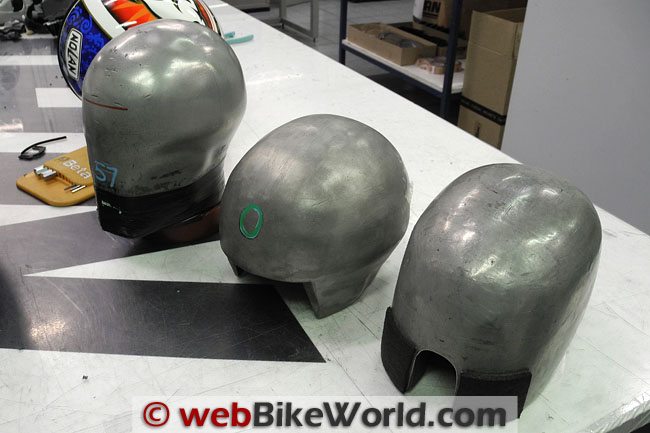
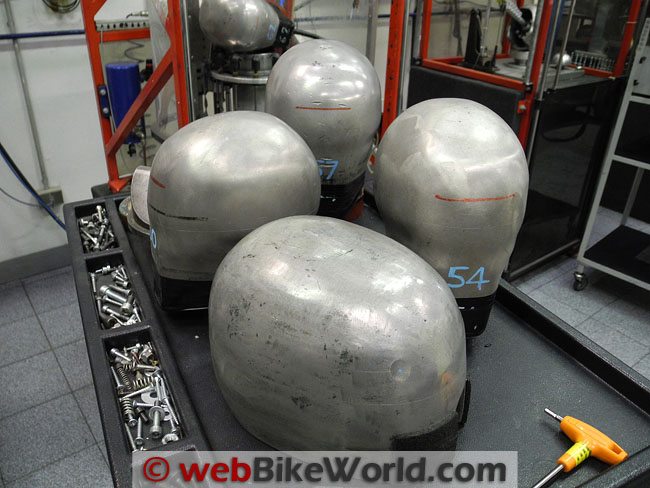
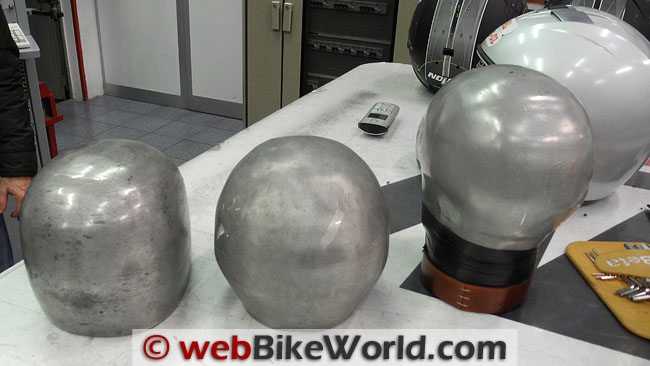
Headform Sizes and Shapes
The DOT headform comes in three different sizes: S, M and L (reference the 571.218 standard information in the next section). Size small weighs 7.8 lbs. (3.5 kg); size medium weighs 11.0 lbs.(5.0 kg); and size large weighs 13.4 lbs. (6.1 kg).
This range is designed to cover the estimated range of human head weights, which is said to range from about 3.5 kg to 5.0 kg.
Surprisingly, there doesn’t seem to be a consensus on exact head weights or head dimensions vs. head size (but we all know that some human heads are much lighter than others, right?).
In any case, for purposes of motorcycle helmet protection, I’d guess that a few grams here or there isn’t going to make much of a difference. But what about those shapes?
The ECE headform comes in 8 different head sizes, ranging from size 50 to 62 with a mass of 3.1 kg for the size 50 to 6.1 kg for the size 62 (reference the ECE headform chart, second illustration below and the ECE Standard No. 22 in the next section).
[UPDATE: ECE 22.05 calls for five ISO headforms, not 8 (section 7.3.3.2). The table in Figure 1A lists the 8 headform sizes that exist only on paper, but only the A, E, J, M and O are used. There are many more sizes described in EN960, a headform standard.]To summarize the headform differences, DOT uses three headforms and ECE uses five (with a potential for eight). Their weight ranges are about the same.
In theory, the ECE headform weights, spread across a larger range of headform sizes, might allow the helmet manufacturer to calibrate the EPS (expanded polystyrene) liner more accurately for the particular helmet size.
So which headform more accurately represents your head? Like most of the other issues surrounding motorcycle helmet protection standards, there really isn’t an answer.
I know of no studies that have compared the relative protection capabilities of the headforms (although such studies may exist), so it’s difficult to say whether one approach is more valid than the other.
Headform Shape vs. Helmet Fit?
One other noticeable difference is in the shape of the headforms. The DOT, ECE and other helmet standards go into great detail on the size, weight, shape and construction of the headforms.
Each headform has a large matrix of dimensions that are used to program the computer-controlled machine tools that make the headforms. This ensures the accuracy of the standard headform size and weight.
Looking at the headforms, the ECE shape appears to be narrower than the DOT shape.
The DOT headform runs from 4.784 in. for the size small to 5.350 in. for the size medium to 5.720 in. for size large, while the ECE headforms range from 88.1 mm (3.4685 in.) for the size A to 108.7 mm (4.2795 in.) for size O — quite a difference.
Again, I’m not sure what inferences can be drawn from these differences other than perhaps the narrower range of sizes for the ECE headforms may be in some way responsible for the differences we experience in the internal shape of ECE-only helmets?
If the helmet is optimized for a specific headform shape, then it’s possible that shape will carry over into the fit that the rider experiences.
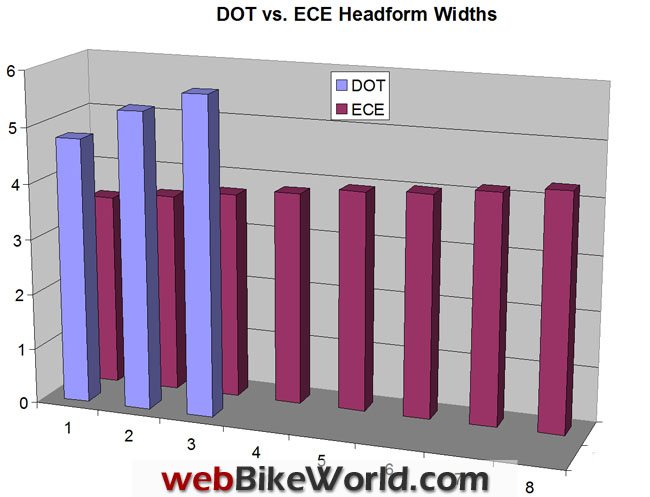
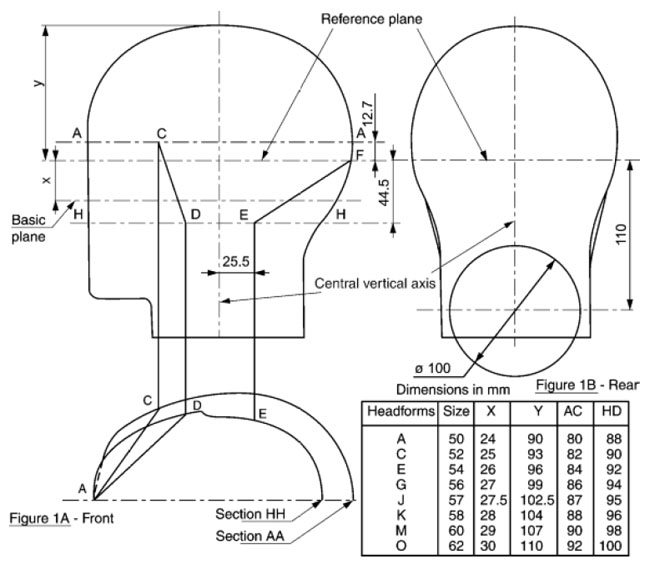
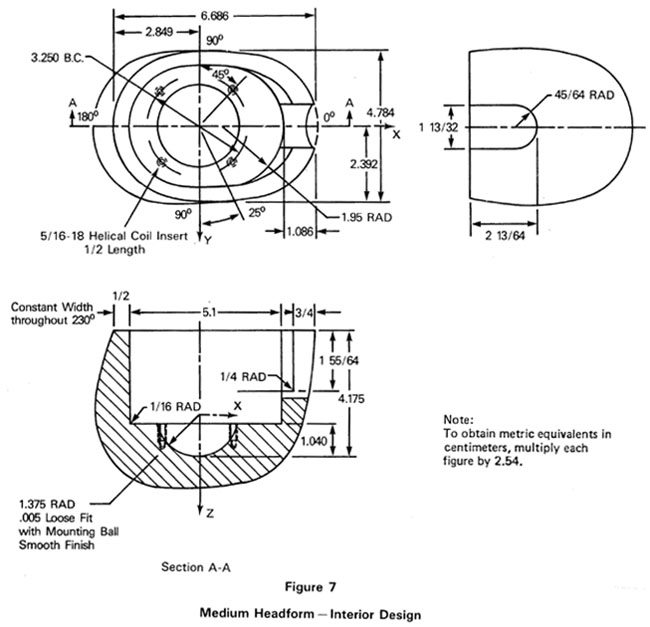
Standards and More Standards…
Monitoring changes to worldwide standards can be difficult, but motorcycle helmet safety standards are relatively stable, which is both good and bad news.
For example, the U.S. Department of Transportation, Federal Motor Carrier Safety Administration, Part 571, which contains the 571.218: Standard No. 218; Motorcycle Helmets that is colloquially known as the “DOT helmet safety standard”, was first published under section 103 of the National Traffic and Motor Vehicle Safety Act of 1966 (reference).
Standard No. 218 was amended several times since then, with the last revision having been published way back in 1988 — April 15th, to be exact (Note: Here are the official test lab procedures in .pdf format).
[UPDATE: FMVSS 218 and all FMVSSs came from the 1966 Highway Safety Act. FMVSS 218 was first published in 1974.The 1988 version is still in effect but there is an updated version stuck in the Office of the General Counsel at NHTSA that should be out any week/month/year now.]
Much has changed in the world since then, with technology, traffic and vehicle differences and in motorcycling and motorcycle helmets, so I’ll leave it up to you to decide the merits of using a safety standard that hasn’t changed in 22 years.
Although I suppose we can look at the bright side and imagine that the standard is so good that it doesn’t need to be changed, right?
Nevertheless, comparing the DOT and ECE standards is difficult at best and much like comparing apples and oranges. Depending on how you interpret the information, there are good points and not-so-good points about both standards.
And don’t forget that DOT and ECE aren’t the only helmet safety standards in the world.
There is the Australian/New Zealand AS/NZS 1698:2006 standard; the Japanese JIS T 8133:2000 standard; the UK SHARP testing regime (info), which may or may not be a “standard” per se and more standards from Indonesia, India, Brazil and others.
By the way, the standard commonly referred to as “ECE 22.05” should probably more accurately be called “Regulation No. 22” because over 2 hours of searching while researching this article came up empty on any search results for “ECE 22.05”.
This is discussed on the webBikeWorld ECE 22.05 information page, but to repeat, here is the page with .pdf downloads of the European motorcycle helmet safety standards.
And here is the direct link for the .pdf file of Regulation No. 22 “Protective Helmets and their visors for drivers and passengers of motor cycles and mopeds“, which actually doesn’t use the phrase “ECE 22.05”, so I wonder where the term came from?
[UPDATE: ECE 22.05 is the same sort of “nickname” for Regulation No. 22 as “DOT” is for FMVSS 218.]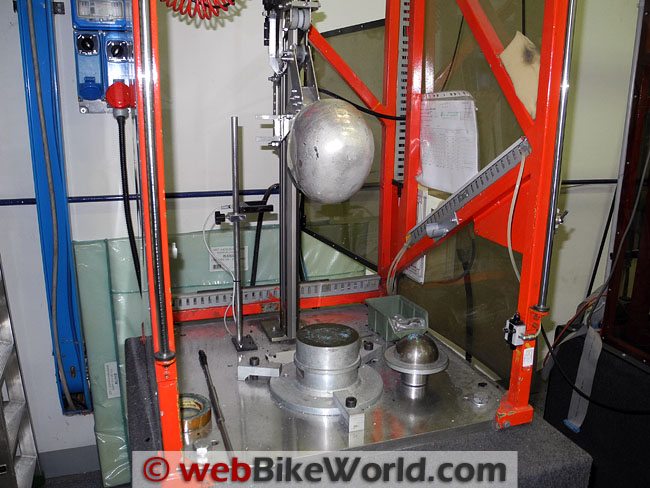
Tests and More Tests…
Each helmet safety standard lists a regimen of tests and procedures that helmets must past to be certified or homologated.
These tests are also usually preceded by “conditioning” of the helmets; that is, the helmets must first be subjected to standard environmental conditions, including moisture, temperature ranges and even solvents.
This helps ensure that the helmet and the helmet shell will be tested under conditions similar or worse than might be experienced in the field when used by customers.
After the helmet conditioning regimes, the tests include the “drop test”, designed to gauge the amount of energy the helmet, shell and padding can absorb, distribute and dissipate.
The drop test involves placing the helmet on the headform and dropping it from a specified distance at a specified speed on to various shapes.
The shapes are designed to represent road obstructions, such as flat surfaces, curved or hemispherical surfaces, curbs (kerbs) and other obstructions that might be encountered as one is slip-sliding down the road after being separated from the bike.
Other tests include visor/face shield penetration tests; chin strap retention and helmet roll-off tests; and a shell rigidity test required for ECE but not DOT. There are other tests, depending on the standard required by various countries.
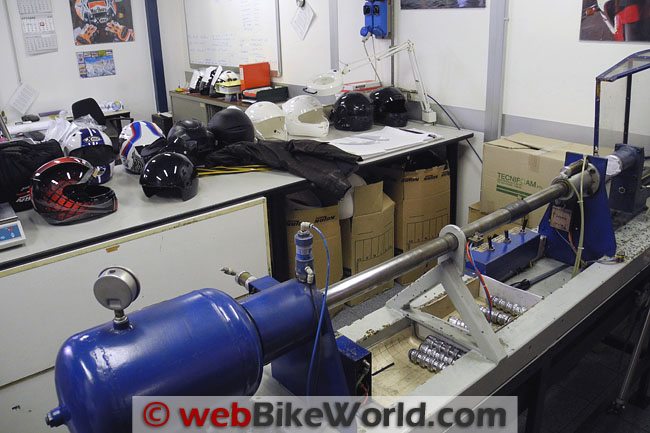
This Is Going to Hurt!
One of the main differences between the DOT and ECE helmet testing standards is apparent in the so-called “drop test”.
These tests are described in some detail in the standards, along with the configurations of the apparatus required to perform the tests.
Although I did not witness anything close to a full testing regime for each standard, Nolan demonstrated the DOT drop test using a Nolan X-402GT helmet.
One Difference
The most obvious differences between the DOT and ECE drop tests are in the testing rigs used for the drop tests. This was apparent to me as soon as I walked into the Nolan test labs, because the drop test apparati dominate the room.
The DOT test uses a guided rail system, which ensures that the helmet drops in exactly the same location, and the DOT test also requires two drops in that location.
Another Difference
Other differences include the anvils or plates that are used to stop the helmet; in other words, the types of surfaces on which the helmet is dropped.
The DOT test uses a flat anvil and a hemispherical anvil, whilst the ECE test uses a flat anvil and a “kerbstone” anvil.
A kerbstone anvil looks vaguely similar to a hemispherical anvil, but it is “taller, sharper and pointier”, to use an unscientific description.
The ECE drop test is (relatively) unguided, but requires one drop. The relative merits of a one-drop vs. a two-drop test is also the source of some controversy.
I try to keep an open and inquisitive mind about this subject and come to a personal understanding of my comfort level regarding the pros and cons of each test. Like most things in life, there really is no black and white “better” or “best” method — at least not yet.
There are compromises and there are…compromises, just like there are for any decision.
For example, one faction rails against the two-drop DOT test, basically saying that the chances of a rider’s (helmeted) head hitting the ground in exactly the same spot are almost zero.
That’s fine, except for that word “almost”.
The compromise is this: a helmet may optimize the energy absorption in one location for one impact and transmit a lower amount of energy.
Or perhaps it can be optimized in a way which will transmit more energy on the first impact but still control the energy transfer on the second impact.
This can be done, and it’s illustrated in the video.
The first drop of the Nolan X-402GT on to the flat anvil registered 126 G and the second drop registered 177 G. I didn’t record the amount of time in milliseconds that it takes to dissipate the energy, also an important consideration.
But the ECE limit for one drop is 275 G and the DOT limit is 400 G, so the Nolan X-402GT passed with flying colors. I’ll take one!
[UPDATE: The FMVSS 218 (DOT Standard) dwell time limit of 2.0 milliseconds at 200g effectively means that the helmet can’t pass the test with over 250g, so the 400g is almost moot.]About that EPS…
Also illustrated in the video is the vital role played by the EPS liner. In the Nolan quality control lab, a weight was shot against a polycarbonate helmet shell with no liner. The damage is obvious and severe.
But put the liner in a polycarbonate shell and try it again and now the impact is distributed through the EPS, so the shell looks nearly undamaged, although the EPS is flattened.
This illustrates the importance of EPS and also why a helmet must be replaced after it has been damaged.

And Polycarbonate vs. Composite?
Again, there are compromises.
A composite helmet shell usually is lighter in weight, and the composite helmet has to pass the same standard tests. But the helmet shell will delaminate or worse in an impact, although it will still distribute the energy within the specifications called out in the standards.
But to make a definitive statement that one is better than the other is difficult.
In fact, after seeing the abuse it can take (watch the video), I now have a healthier respect for good ol’ polycarbonate. It may make for a slightly heavier helmet, but I like the way it absorbs energy without shattering.
One More Difference
The ECE drop test is unguided — more or less — and calls for one drop from 2.85 meters on to a flat anvil and kerbstone anvil. The DOT drop test specifies a minimum distance but also a drop speed, with section S7.1.4(b) stating
“The guided free fall drop height for the helmet and test headform combination onto the flat anvil shall be such that the minimum impact speed is 7 ft./sec (2.13 m/sec). The minimum drop height is 72 inches (182.9 cm). The drop height is adjusted upward from the minimum to the extent necessary to compensate for friction losses.”
So is one better than the other? Again, I think this is impossible to say.
On the one hand, having a guided test allows the helmet to fall in a precise location each time. But when this exact spot is known beforehand, the system might be gamed so that the EPS provides more protection in that spot only.
Having the helmet fall on a random location (it actually isn’t completely random in the ECE test) means that the helmet and EPS must theoretically provide the same protection in different areas of the helmet because the manufacturer doesn’t know ahead of time on which spot the helmet will fall.
What About Snell?
By the way, the Snell tests are slightly different. In addition to the flat and hemispherical anvil tests, Snell also incorporates an edge anvil test and a roll bar test.
For the flat and hemispherical tests, the helmet is dropped twice from 3.06 meters and 2.24 meters for the second drop. The helmet is dropped once on the edge anvil, which looks like a section of plate standing on edge.
Finally, the helmet is dropped three times on a roll bar anvil, which looks like a round bar. As far as I know, the maximum peak acceleration is limited to 300 G for these tests.
The Snell standard also includes a chin bar test (5 kg weight is dropped on the chin bar with the chin bar pointed up and the downward deflection is measured) and a penetration test.
[UPDATE: Snell M2010 (description and information) is changed from previous (Snell) standards. It’s greatly improved (from my Snell discussion). Also, M2005 is still being supported by Snell in spite of the M2010 introduction.]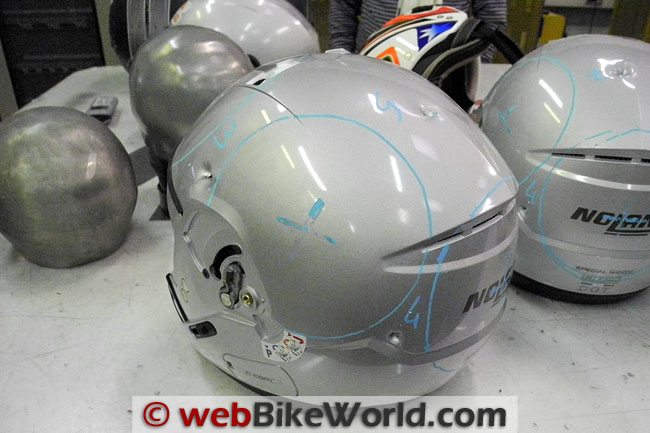
And What About SHARP?
The recent SHARP testing scheme in the UK is based on ECE standards, but it is a voluntary system that is designed to test helmets to the ECE COST 327 study (.pdf) findings (COST = Cooperation in the Field of Scientific and Technical Research).
SHARP uses a guided drop test based on the BSI 6658 standard developed in 1985 and uses the ECE headforms, which is interesting, as they say that a guided drop helps minimize energy dissipation due to helmet rotation in the ECE test.
The SHARP test also uses the ECE flat and kerbstone anvils. The system also includes one higher and one lower impact speed test than the ECE standard.
Their one- to five-star rating is also based on 32 drops on a sample size of 7 helmets and different velocities, then the rating is weighted to take into account the frequency of crash types taken from the COST 327 study.
If you’ve read this far in this article, you’re probably interested in the topic of motorcycle helmet safety and design, so I would urge you to download and read the 327 page (thus COST 327) document.
It is without doubt the most up-to-date study detailing motorcycle accidents with highly detailed data on accident types and head injuries, including locations on the helmet where the impacts occurred and in what frequencies.
[UPDATE: Some flip-up helmets have difficulties with the SHARP oblique impact test because the side impact locations are located near the flip-up visor pivot mechanism, so performance in the test may be reduced.Here’s an animation on the SHARP website that illustrates a SHARP helmet test.]
Penetration Counts
One other big difference between the DOT (and Snell) and ECE tests is the penetration test required for DOT and Snell. This test does not exist in the ECE standard.
The penetration test (which is/was also required in the old British Standards Institute BSI 6658-85 Type A standard) is a drop on to the helmet shell by a cone with a 60-degree angle shape.
It comes to a point and the helmet must not allow the point to impact deep enough to touch what would be the rider’s head.
This test has also generated some controversy, with some saying the chances of something penetrating a helmet shell are low. But again, it depends on the individual rider’s tolerance level for taking the chance.
It has led to some interesting differences in the helmets sold in the U.S. (and Canada) vs. the ECE counterparts.
This is most obvious in the ECE version of the Nolan N43 “Air” (review) compared to the Nolan N43 “Trilogy”, which is the DOT version of the same helmet.
The N43 Air has a large “sunroof” style vent on top, while the N43 has a completely different venting system because the original would never pass the DOT penetration test.
Is this a good or bad thing? Another ECE helmet, the upcoming Caberg Ego (info) that I handled at the recent EICMA 2010 show, also has a huge see-through vent opening on top.
I’ll have to admit that as much as I admire the potential for ventilation that this system could provide, I’m a bit troubled by the reduction in helmet shell surface area covering that area.
So perhaps the DOT and Snell penetration test isn’t so bad after all, although maybe it’s time for a slight modification in the test criteria.
Note that the penetration test usually means a different or thicker helmet shell, which can add weight, which is why DOT and/or Snell helmets can sometimes weigh more than their ECE counterparts.
[UPDATE (From Dave T’s comments below): “Yes, the DOT / Snell penetration test requires a tougher shell which adds weight. There is a good argument that we don’t need a penetration test.The double impacts under DOT and Snell are hard to justify since it rarely happens in real crashes. Like you say, the qualifier rarely or seldom is the sticky wicket. As long as the double impacts are at a reasonable level like in DOT, it certainly doesn’t hurt.”]
And (Almost) Finally…
Yet another difference between the standards has to do with compliance. The DOT standard is self-policing, at least in terms of compliance.
CORRECTION: I originally stated that “the U.S. Department of Transportation doesn’t send undercover helmet inspectors to motorcycle retailers to pull helmets off the shelf and test them to make sure they comply. Instead, they simply take the manufacturer’s word for it that the helmet meets the standard.”
Actually, this isn’t correct! “DOT is based on manufacturers’ self-certification but NHTSA (National Highway Traffic Safety Administration) tests 40 models a year purchased from retail so it’s far more than the honor system. DOT’s compliance testing results in recalls so it has real teeth”, according to Dave T. (below).
And from the NHTSA page entitled “Importation and Certification FAQs“, Section 9, comes this statement: “NHTSA enforces the standard by randomly selecting and purchasing motorcycle helmets from the marketplace and testing to the requirements of the standard at independent test labs”.
For example, in 2006 (latest year for which I could find data), after re-testing an unknown number of helmet brands and types, 13 formal performance investigations were initiated and ended with 7 recalls covering 42,125 helmets (From “Counterfeit and Noncompliant Safety Equipment – Motorcycle Helmets (.pdf)).
Of course, if you’re a manufacturer selling helmets that don’t meet the standard, you could get caught. It apparently happens…sometimes.
This is why it is crucial to only buy a helmet from a reputable dealer and a reputable, name-brand manufacturer that has a retail track record and a national sales and service presence. In theory, they’d have too much to lose to make the foolish mistake of scamming the DOT testing process.
I don’t have all of the details of the ECE compliance process, but Nolan said that helmets are routinely and randomly pulled off the dealers’ shelves and re-tested to ensure they meet the standard.
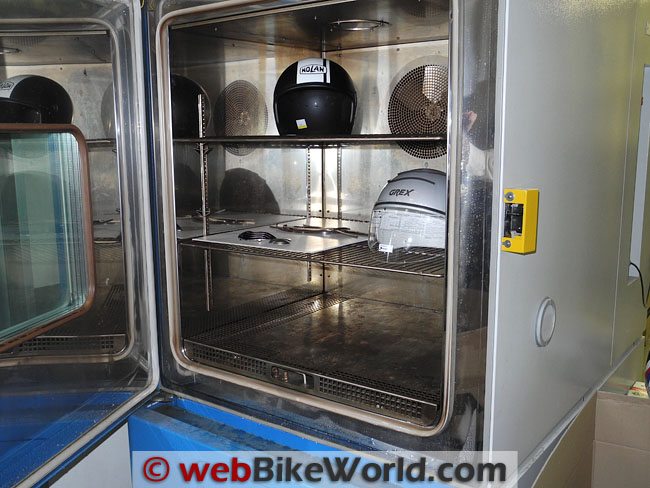
And the Conclusion Is?
I learned a lot during my visit to the Nolan test labs, but unfortunately this knowledge doesn’t make choosing a motorcycle helmet safety standard any easier.
There are many compromises, and hopefully I have at least provided some information that can help you decide.
One thing’s for sure: it’s really not possible to definitively state that one helmet standard is “better” than another. The biggest reason for that?
After all the technical information is digested and the numbers are crunched, we as motorcyclists still do not really know which standard and which test more closely simulates the types of impacts we might experience in the real world?
Unfortunately, there has been very little scientific testing and analysis of this issue, the most important of all.
Is a two-drop test on a flat anvil representative of what might happen in a motorcycle accident? Is a penetration test relevant? Or what about the edge test or kerbstone test? Is an unguided or guided drop more realistic?
Perhaps it would be nice if each new helmet was provided with test results so that we knew the amount of G force the helmet will dissipate and over what duration. But this information isn’t available to the helmet buying public.
So in the end, the only thing we can depend on is the standards and hope for the best.
Note also that a DOT helmet may have a different shell construction or thickness to allow it to pass the DOT penetration test.
It’s not necessarily the case that an ECE helmet will automatically meet DOT standards or vice versa, which is why I’m puzzled at some of the helmets that have a dual ECE/DOT homologation label.
In fact, it’s my understanding that the EC has a ruling that requires that a helmet to be marked with ECE labels only when it is sold in an EC country. The ECE 22.05 labeling must not be on the helmet when it is sold elsewhere.
However, distributors and importers around the world routinely disregard this ruling (which applies to helmet manufacturers in the EC only and probably could only be enforced there), because many helmets are sold with, for example, “DOT and ECE 22.05 approved” stickers on the back.
Also, whether or not any one helmet type with the same shell and construction can meet DOT, ECE and Snell 2010 standards simultaneously is unknown.
| Some Differences Between DOT and ECE Helmet Standards | |
|---|---|
| DOT | ECE |
| Two drop test | One drop test |
| Flat anvil and hemispherical anvil | Flat anvil and kerbstone anvil |
| Guided | Unguided |
| Penetration test | No penetration test |
| Self-compliance | Regulatory compliance |
| 400G max for either of two drops | 275G max after one drop |
| S, M, L headform sizes | 8 headform sizes |
| DOT headform shape | ECE headform shape |
| Date helmet was manufactured label | Serial number label only |
This is another reason we always recommend buying a helmet from a name-brand, recognized manufacturer with a worldwide reputation for performance and quality.
Finally, here’s what we’d like to see in the DOT standard:
- Updated test procedures that are more closely harmonized with ECE and other world standards with the goal of eventually accepting one single standard for motorcycle helmet safety. This would potentially lower the cost of motorcycle helmets and provide a greater choice of helmets for riders in the U.S.
- Every test report for every helmet sold in the U.S. should be readily available for download in the DOT Office of Vehicle Safety Compliance Database.Not just the helmets that were randomly selected for re-testing, but every single helmet tested to FMVSS 218 and sold in the U.S. The test reports are available; they are created by the testing labs when the manufacturer homologates the helmet.So there’s no reason these shouldn’t be made available to consumers.
- Continuing research into the causes and prevention of motorcycle accidents, along with continued research on improving the performance of motorcycle helmets.
In the ECE standard, we’d like to see a manufacturing date label requirement. Currently the standard requires that the helmet has only a serial number. The DOT standard requires a label in the helmet that indicates the date the helmet was manufactured.
The date of manufacture is used by helmet buyers to determine how “fresh” the helmet is and the date is also used by some track day and race sponsors to ensure the helmet is from a recent build.
Apparently the only way to find out the date that an ECE helmet was manufactured is to contact the manufacturer or government authorities with the serial number and get it translated into a date.
If you have any feedback or can clarify any of the information provided in this article, please contact me at the address below; it would be nice to develop a discussion about the pros and cons of the various standards.
Owner Comments and Feedback
See details on submitting comments.
From “C.R.” (11/10): “Thanks again for such a great article. I would like to help you with completing some of the information though:
- The ECE standard requires that the helmet has a label sewn onto the chin strap or padding with the ECE test number on it. This is the only way of having a ECE approved helmet in Europe.So the sticker on the back helmets sold in the USA/Canada that says ECE & DOT means nothing as far as acceptance in Europe is concerned if it doesn’t also have the sewn sticker.This is important for people buying one of these helmets and thinking of taking it to Europe for vacation. Fines in countries that only accept ECE helmets are very high. Particularly in Italy.
- Not all countries in Europe require a ECE tested helmet yet (German Motor Vehicle Act only talks about an acceptable helmet for the purpose) but some exclusively (i.e. Italy) and then insist on the newest or only one cycle older test. The latest version being 05 hence 22.05 (previous 22.04 etc.).
- ECE does require a chin impact test as well (just like Snell although at different speeds I believe) for helmets that are certified as such (Integral, Flip-Up). Open face helmets have a different test standard (obviously).Some flip up models are certified for both (i.e., Shark, Nolan) open and closed face test regime and can therefore be legally worn open while riding.
- As you know, the new Snell 2010 test is now a closer match to the ECE test speeds and impact criteria. The ECE chin impact is for 5.5 meters per second.But most independent tests (ADAC [German Automobile Club], motorcycle magazines and “Stiftung Warentest” [Consumer Reports in Germany] do also test at the 7.5 meters per second impact speed for the chin impact.”
From “H.B.” (11/10): “Thanks for very informative DOT vs ECE safety standards article. After seeing the Nolan crash test facility I now feel safer with my X-Lite X-802 helmet. Up until I read your article, I only trusted OGK FF5 (on account of being manufactured in Japan).
Although I did not have any complaints (as with Akuma), the X-802 was never my favorite helmet. Now, I may even use it on the track as it is fitted with a Pinlock, and may do better in this cold weather.”

